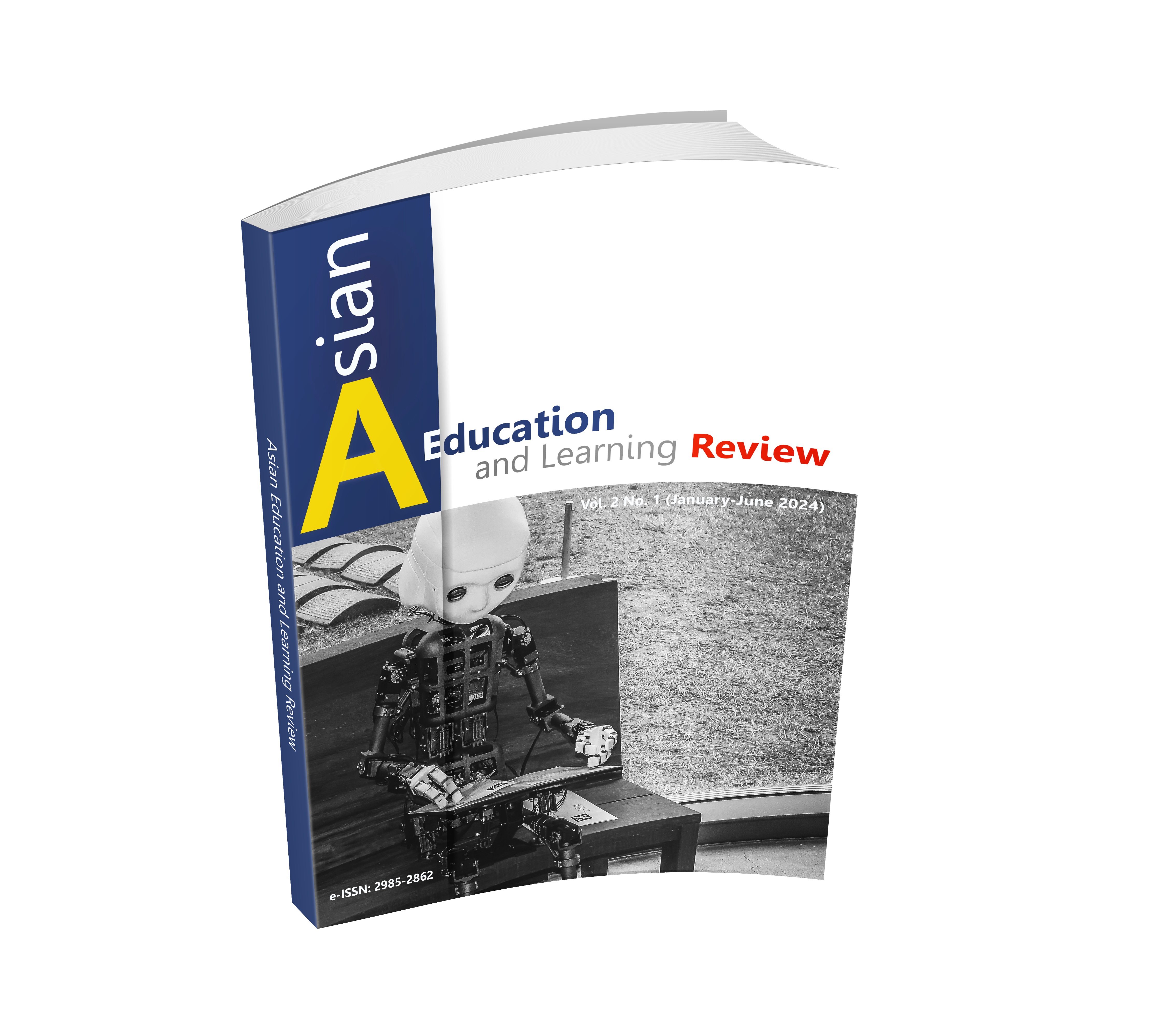THE ROLE OF DIGITAL LITERACY IN SHAPING EDUCATION IN THE NEXT-NORMAL
DOI:
https://doi.org/10.14456/aelr.2024.3Keywords:
Digital Literacy, Shaping Education, Next-NormalAbstract
The rapid adoption of digital technologies in education, spurred on by the disruptions caused by the COVID-19 pandemic, has led to significant changes. This paper examines the critical role that digital literacy plays in reshaping education as we move toward the "normal," as it is known. This paper aims to explore the role of digital literacy in shaping education in the next-normal. The paper methodology integrates a comprehensive literature review from reputable sources like PubMed and Scopus, focusing on emerging themes to uncover insights into digital literacy's influence on pedagogy and student outcomes. The results found that; (1) Digital literacy for educational equity and inclusion; addressing the digital divide, ensuring access to digital learning opportunities, and promoting diversity and inclusion through digital literacy. (2) Digital literacy for 21st-century skills development; critical thinking and problem-solving, collaboration and communication, and creativity and innovation. And (3) digital literacy and educational policy; national and international initiatives, policy implications for curriculum development and teacher training, and future directions and recommendations. In conclusion, Digital literacy becomes the fundamental component of education in the next normal, encouraging creativity, fairness, and flexibility. Proficiency in digital literacy is imperative for both educators and students to effectively navigate the dynamic landscape of education. Education can fully utilize technology by fostering digital literacy, which will guarantee equal access and equip students to succeed in a world driven by technology.
Downloads
References
Bawden, D. (2008). Origins and concepts of digital literacy. In D. Lankshear, & M. Knobel. (eds.). Digital literacies: Concepts, policies, and practices (pp. 17-32). New York: Peter Lang Publishing, Inc.
Belshaw, D. (2011). What is 'digital literacy'? A pragmatic investigation. TechTrends, 55(2), 37-48.
Brown, A., & Johnson, C. (2019). Digital literacy and student engagement: Examining the relationship. Journal of Educational Technology, 36(2), 245-261.
Carretero, S., Vuorikari, R., & Punie, Y. (2017). DigComp 2.1: The Digital Competence Framework for Citizens with eight proficiency levels and examples of use (Working Paper JRC106281). Varese: Joint Research Centre.
Ertmer, P., Ottenbreit-Leftwich, A., Sadik, O., Sendurur, E., & Sendurur, P. (2012). Teacher beliefs and technology integration practices: A critical relationship. Computers & Education, 59(2), 423-435.
Friedman, A. (2016). Diversity and inclusion in technology: What can we do differently?. In Proceedings of the 2016 ACM Conference on Designing Interactive Systems (pp. 1199-1210). Brisbane: QLD Australia.
García-Peñalvo, F., & Conde, M. (2014). Understanding digital competence in the framework of lifelong learning. In F. García-Peñalvo. (ed.). Digital literacy: Concepts, methodologies, tools, and applications (pp. 1393-1404). Pennsylvania: IGI Global.
Gikandi, J., Morrow, D., & Davis, N. (2011). Online formative assessment in higher education: A review of the literature. Computers & Education, 57(4), 2333-2351.
Gilster, P. (1997). Digital Literacy. New Jersey: Wiley.
Gonzalez, R. (2016). Digital Equity: New Findings and Perspectives. Teachers College Record, 118(7), 1-26.
Hatlevik, O., & Hatlevik, I. (2018). Digital competence in teacher education: A study of the digital competence of Norwegian student teachers. Scandinavian Journal of Educational Research, 62(4), 536-555.
Hrastinski, S. (2019). A theory of online learning as online participation. Computers & Education, 136, 113-127.
Hsin, C., & Cigas, J. (2013). Short-term effects of integrated science and English language arts instruction on students' science and English language arts understanding. Journal of Research in Science Teaching, 50(3), 318-338.
JISC. (2014). Developing Digital Literacies. Retrieved from www.jisc.ac.uk/guides/developing-digital-literacies.
Jones, L., & Smith, J. (2020). The impact of educators' digital literacy on technology integration in education. Educational Technology Research and Development, 68(4), 1747-1765.
Jones, L., Clark, M., & Brown, A. (2021). Enhancing student collaboration through digital literacy: A case study of online group projects. Computers & Education, 158, 104072.
Kaplan, A. (2020). If you survive COVID-19, you’ll likely be a digital expert. Retrieved from https://sloanreview.mit.edu/article/if-you-survive-covid-19-youll-likely-be-a-digital-expert/.
König, J., Jäger-Biela, D., & Glutsch, N. (2021). Adapting to online teaching during COVID-19 school closure: Teacher education and teacher competence effects among early career teachers in Germany. European Journal of Teacher Education, 44(4), 608-622.
Kurbanoglu, S., Akkoyunlu, B., & Umay, A. (2010). Developing the information literacy self-efficacy scale. Journal of Documentation, 66(6), 841-862.
Livingstone, S., & Helsper, E. (2007). Gradations in digital inclusion: Children, young people, and the digital divide. New Media & Society, 9(4), 671-696.
Martin, S., Diaz, G., Sancristobal, E., Gil, R., Castro, M., & Peire, J. (2011). New technology trends in education: Seven years of forecasts and convergence. Computers & Education, 57(3), 1893-1906.
Ribble, M. (2015). Digital Citizenship in Schools: Nine Elements All Students Should Know. 3rd ed. Washington, D.C.: International Society for Technology in Education.
Silvernail, D., & Gritter, K. (2007). Maine's middle school laptop program: Creating better writers. Journal of Technology, Learning, and Assessment, 6(2), 1-44.
Smith, J., & Clark, M. (2018). Leveraging digital literacy for interactive learning: A case study of multimedia integration in the classroom. Journal of Interactive Learning Research, 29(2), 289-305.
Thompson, C. (2013). Digital literacy in the digital age: The need for expanded technological pedagogical content knowledge (TPACK) in preservice teachers. Journal of Adolescent & Adult Literacy, 57(3), 228-237.
United Nations Educational, Scientific and Cultural Organization. (2020). Education: From disruption to recovery. Retrieved from https://en.unesco.org/covid19/educationresponse.
Van Dijk, J. (2019). The Digital Divide. New Jersey: Wiley.
Warschauer, M. (2003). Technology and social inclusion: Rethinking the digital divide. Massachusetts: MIT Press.
Warschauer, M., & Matuchniak, T. (2010). New technology and digital worlds: Analyzing evidence of equity in access, use, and outcomes. Review of Research in Education, 34(1), 179-225.

Downloads
Published
How to Cite
Issue
Section
License
Copyright (c) 2024 Authors

This work is licensed under a Creative Commons Attribution-NonCommercial-NoDerivatives 4.0 International License.






.png)


